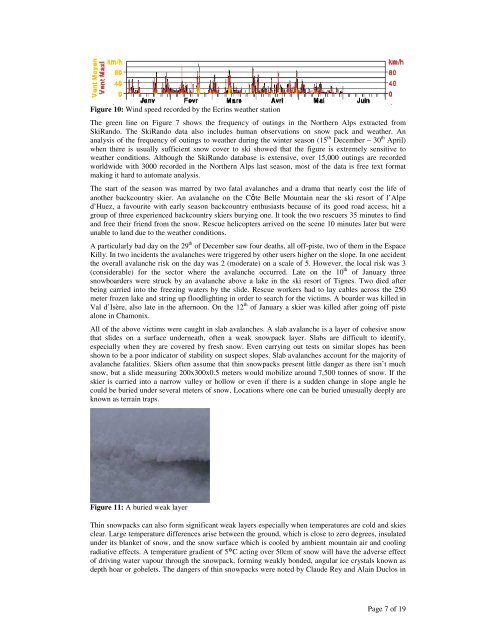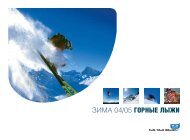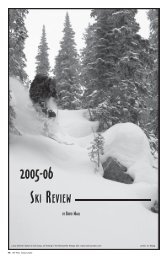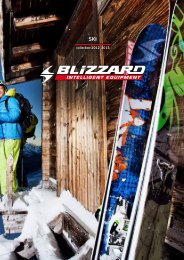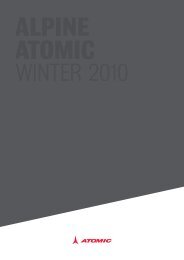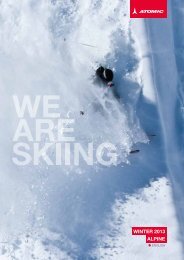Analysis of off-piste and backcountry accidents in France ... - Rasc.ru
Analysis of off-piste and backcountry accidents in France ... - Rasc.ru
Analysis of off-piste and backcountry accidents in France ... - Rasc.ru
You also want an ePaper? Increase the reach of your titles
YUMPU automatically turns print PDFs into web optimized ePapers that Google loves.
Figure 10: W<strong>in</strong>d speed recorded by the Ecr<strong>in</strong>s weather station<br />
The green l<strong>in</strong>e on Figure 7 shows the frequency <strong>of</strong> out<strong>in</strong>gs <strong>in</strong> the Northern Alps extracted from<br />
SkiR<strong>and</strong>o. The SkiR<strong>and</strong>o data also <strong>in</strong>cludes human observations on snow pack <strong>and</strong> weather. An<br />
analysis <strong>of</strong> the frequency <strong>of</strong> out<strong>in</strong>gs to weather dur<strong>in</strong>g the w<strong>in</strong>ter season (15 th December – 30 th April)<br />
when there is usually sufficient snow cover to ski showed that the figure is extremely sensitive to<br />
weather conditions. Although the SkiR<strong>and</strong>o database is extensive, over 15,000 out<strong>in</strong>gs are recorded<br />
worldwide with 3000 recorded <strong>in</strong> the Northern Alps last season, most <strong>of</strong> the data is free text format<br />
mak<strong>in</strong>g it hard to automate analysis.<br />
The start <strong>of</strong> the season was marred by two fatal avalanches <strong>and</strong> a drama that nearly cost the life <strong>of</strong><br />
another <strong>backcountry</strong> skier. An avalanche on the Cte Belle Mounta<strong>in</strong> near the ski resort <strong>of</strong> l’Alpe<br />
d’Huez, a favourite with early season <strong>backcountry</strong> enthusiasts because <strong>of</strong> its good road access, hit a<br />
group <strong>of</strong> three experienced <strong>backcountry</strong> skiers bury<strong>in</strong>g one. It took the two rescuers 35 m<strong>in</strong>utes to f<strong>in</strong>d<br />
<strong>and</strong> free their friend from the snow. Rescue helicopters arrived on the scene 10 m<strong>in</strong>utes later but were<br />
unable to l<strong>and</strong> due to the weather conditions.<br />
A particularly bad day on the 29 th <strong>of</strong> December saw four deaths, all <strong>of</strong>f-<strong>piste</strong>, two <strong>of</strong> them <strong>in</strong> the Espace<br />
Killy. In two <strong>in</strong>cidents the avalanches were triggered by other users higher on the slope. In one accident<br />
the overall avalanche risk on the day was 2 (moderate) on a scale <strong>of</strong> 5. However, the local risk was 3<br />
(considerable) for the sector where the avalanche occurred. Late on the 10 th <strong>of</strong> January three<br />
snowboarders were st<strong>ru</strong>ck by an avalanche above a lake <strong>in</strong> the ski resort <strong>of</strong> Tignes. Two died after<br />
be<strong>in</strong>g carried <strong>in</strong>to the freez<strong>in</strong>g waters by the slide. Rescue workers had to lay cables across the 250<br />
meter frozen lake <strong>and</strong> str<strong>in</strong>g up floodlight<strong>in</strong>g <strong>in</strong> order to search for the victims. A boarder was killed <strong>in</strong><br />
Val d’Isère, also late <strong>in</strong> the afternoon. On the 12 th <strong>of</strong> January a skier was killed after go<strong>in</strong>g <strong>of</strong>f <strong>piste</strong><br />
alone <strong>in</strong> Chamonix.<br />
All <strong>of</strong> the above victims were caught <strong>in</strong> slab avalanches. A slab avalanche is a layer <strong>of</strong> cohesive snow<br />
that slides on a surface underneath, <strong>of</strong>ten a weak snowpack layer. Slabs are difficult to identify,<br />
especially when they are covered by fresh snow. Even carry<strong>in</strong>g out tests on similar slopes has been<br />
shown to be a poor <strong>in</strong>dicator <strong>of</strong> stability on suspect slopes. Slab avalanches account for the majority <strong>of</strong><br />
avalanche fatalities. Skiers <strong>of</strong>ten assume that th<strong>in</strong> snowpacks present little danger as there isn’t much<br />
snow, but a slide measur<strong>in</strong>g 200x300x0.5 meters would mobilize around 7,500 tonnes <strong>of</strong> snow. If the<br />
skier is carried <strong>in</strong>to a narrow valley or hollow or even if there is a sudden change <strong>in</strong> slope angle he<br />
could be buried under several meters <strong>of</strong> snow. Locations where one can be buried unusually deeply are<br />
known as terra<strong>in</strong> traps.<br />
Figure 11: A buried weak layer<br />
Th<strong>in</strong> snowpacks can also form significant weak layers especially when temperatures are cold <strong>and</strong> skies<br />
clear. Large temperature differences arise between the ground, which is close to zero degrees, <strong>in</strong>sulated<br />
under its blanket <strong>of</strong> snow, <strong>and</strong> the snow surface which is cooled by ambient mounta<strong>in</strong> air <strong>and</strong> cool<strong>in</strong>g<br />
radiative effects. A temperature gradient <strong>of</strong> 5C act<strong>in</strong>g over 50cm <strong>of</strong> snow will have the adverse effect<br />
<strong>of</strong> driv<strong>in</strong>g water vapour through the snowpack, form<strong>in</strong>g weakly bonded, angular ice crystals known as<br />
depth hoar or gobelets. The dangers <strong>of</strong> th<strong>in</strong> snowpacks were noted by Claude Rey <strong>and</strong> Ala<strong>in</strong> Duclos <strong>in</strong><br />
Page 7 <strong>of</strong> 19


